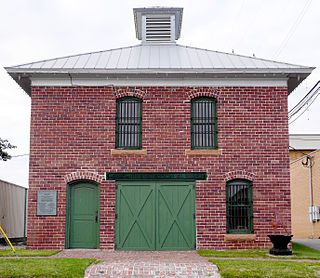
Canadian County is a county located in the U.S. state of Oklahoma. As of the 2020 census, the population was 154,405, making it the fourth most populous county in Oklahoma. Its county seat is El Reno.

Presidio is a city in Presidio County, Texas, United States. It is situated on the Rio Grande River, on the opposite side of the U.S.–Mexico border from Ojinaga, Chihuahua. The name originates from Spanish and means "fortress". The population was 4,169 at the 2000 census, and had increased to 4,426 as of the 2010 US census.

Fort Sill is a United States Army post north of Lawton, Oklahoma, about 85 miles (136.8 km) southwest of Oklahoma City. It covers almost 94,000 acres (38,000 ha).

Fort Davis National Historic Site is a United States National Historic Site located in the unincorporated community of Fort Davis, Jeff Davis County, Texas. Located within the Davis Mountains of West Texas, the historic site was established in 1961 to protect one of the best remaining examples of a United States Army fort in the southwestern United States.
Ben Ficklin (Benficklin), Texas is a ghost town and the former county seat of Tom Green County from 1875 to 1882. It was located 5 miles (8 km) south of Fort Concho on the east bank of the South Concho River.
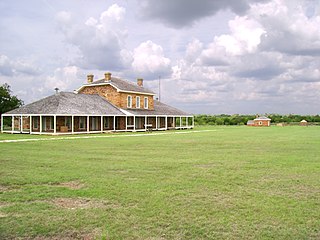
Fort Richardson was a United States Army installation located in present-day Jacksboro, Texas. Named in honor of Union General Israel B. Richardson, who died in the Battle of Antietam during the American Civil War, it was active from 1867 to 1878. Today, the site, with a few surviving buildings, is called Fort Richardson State Park, Historic Site and Lost Creek Reservoir State Trailway. It was designated a National Historic Landmark in 1963 for its role in securing the state's northern frontier in the post-Civil War era.
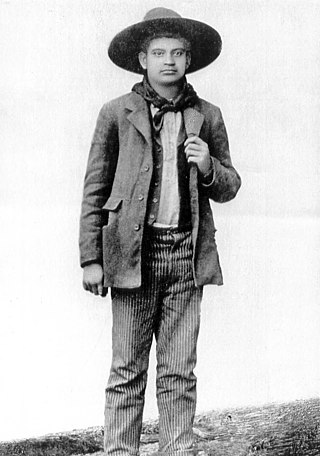
Crawford Goldsby, also known by the alias Cherokee Bill, was an American outlaw. Responsible for the murders of eight men, he and his gang terrorized the Indian Territory for over two years.
Lowake is an unincorporated community in northwestern Concho County, Texas, United States, along the Concho River. It lies along FM 381 north of the town of Paint Rock, the county seat of Concho County. Its elevation is 1,752 feet (534 m). Although Lowake is unincorporated, it has a post office, with the ZIP code of 76855; the post office was established in 1909.
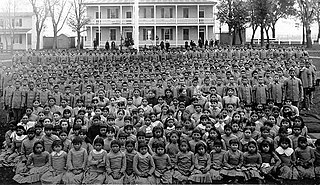
American Indian boarding schools, also known more recently as American Indian residential schools, were established in the United States from the mid-17th to the early 20th centuries with a primary objective of "civilizing" or assimilating Native American children and youth into European American culture. In the process, these schools denigrated Native American culture and made children give up their languages and religion. At the same time the schools provided a basic Western education. These boarding schools were first established by Christian missionaries of various denominations. The missionaries were often approved by the federal government to start both missions and schools on reservations, especially in the lightly populated areas of the West. In the late 19th and early 20th centuries especially, the government paid religious orders to provide basic education to Native American children on reservations, and later established its own schools on reservations. The Bureau of Indian Affairs (BIA) also founded additional off-reservation boarding schools based on the assimilation model. These sometimes drew children from a variety of tribes. In addition, religious orders established off-reservation schools.
The Cheyenne and Arapaho Tribes are a united, federally recognized tribe of Southern Arapaho and Southern Cheyenne people in western Oklahoma.
Finley is an unincorporated community in Pushmataha County, Oklahoma, 10 miles northeast of Antlers.
Walter Richard West Sr., was a painter, sculptor, and educator. He led the Art Department at Bacone College from 1947 to 1970. He later taught at Haskell Institute for several years. West is an enrolled member of the Cheyenne and Arapaho Tribes.

Concho is an unincorporated community and census-designated place (CDP) in Apache County, Arizona, United States. Concho is located on Arizona State Route 61, 14 miles (23 km) west of St. Johns. Concho was the original site for the state capital, due to its prosperous farming. As of the 2010 census, the Concho CDP had a population of 38.
Charles W. Blackwell was an American lawyer, educator, activist, and diplomat, who served as the first Ambassador of the Chickasaw Nation to the United States of America, from 1995 until his death in 2013. Blackwell was the first Ambassador of any Native American tribal government to the government of the United States. From 1990 to 1995, he had served as the Chickasaw Nation delegate to the US Congress, while also working on issues of health, education, and economic development for tribal nations.
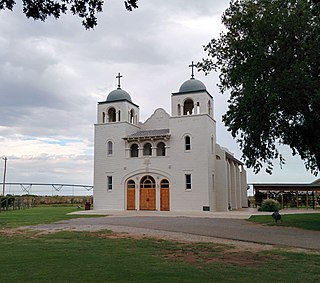
The Darlington Agency was an Indian agency on the Cheyenne and Arapaho Indian Reservation prior to statehood in present-day Canadian County, Oklahoma. The agency was established in 1870. The agency established at Fort Supply the previous year was moved to a more accessible location for the tribes. Brinton Darlington, a Quaker for whom the agency was named, was the first United States Indian agent at the agency, a position he held until his death in 1872.
Viola Hatch was a Native American activist, founding member of the National Indian Youth Council, and former Tribal Chair of the Cheyenne and Arapaho Tribes. She successfully sued the Canton, Oklahoma schools regarding the right of students to obtain an education.
Concho Indian Boarding School was a boarding school for members of the Cheyenne and Arapaho Tribes. It initially served grades 1-6, and later extended classes through grade 8. Admission was later opened to other Native American students.

Juanita L. Learned was the first woman to chair the Cheyenne and Arapaho Tribes. She was Southern Arapaho and was known for her work to keep the Concho Indian School from closing, as well as actions to return the school building, and land and buildings of Fort Reno to her tribe.
Porferio Tirador "Gopher" Armstrong, sometimes called Theodore Armstrong, was a Cheyenne-Caddo painter from Clinton, Oklahoma. Armstrong had a keen interest in art since elementary school. He studied at the Concho Indian School and has exhibited his work across the country. Some of his works are in the permanent collection of institutions including the Oklahoma Historical Society Museum and the Joslyn Art Museum.












